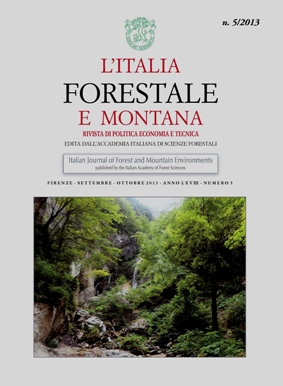Articles
Published 2013-12-10
Keywords
- land use,
- chestnuts orchards,
- pasturage
Copyright (c) 2013 Italian Journal of Forest and Mountain Environments

This work is licensed under a Creative Commons Attribution-NonCommercial 4.0 International License.
Abstract
This work presents an analysis of the evolution of the human activities in the Italian mountain areas, as regardto the agricultural and the forestry land-use. Due to the large area occupied by woodlands, the analysis focuses
on the relationships between Man and forests. Three closely linked systems have been analysed: agriculture,
pasturage and silviculture, which are primary resources employed to satisfy human life needs for food and energy.
At a landscape level, crops and forest products remain departmentalised, even if linked to the pastoral element.
Two typical cases of multifunctional systems have been described: the first one related to the alpine area (Malga
and Maso Chiuso), and the second one concerning the Apennine area (chestnut orchards).The documentation on land-use in mountain areas underlines the deep-seated relationships that have developed over the time between the human activities and the forest. Until the middle of the last century, the agriculture-forestry systems were integrated into a fieldpasture-woodlands complex where the pasture portion was dominant. Today, the forest plays the primary role, since they offer an advantageous capital; correctly managed they can provide a diversified flow of services.

